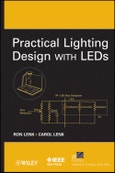Light–emitting diodes (LEDs) are expected to drive huge growth in the lighting industry. The new high–performance LEDs require a new level of knowledge to manage their higher light output, power requirements, and thermal management. Written by authorities in the field, this practical guide helps readers navigate the day–to–day engineering and systems design necessary to build complete LED systems, offering thorough information on the fields of optical performance, power, materials, thermal design, and modeling and measurement.
Beginning with background information on LEDs and lighting, the book then provides in–depth exploration of the optical and electrical characteristics of LEDs; thermal performance and how to manage thermals; and DC and AC drive circuitry. It also looks at system performance and gives detailed examples of lighting design using LEDs. Finally, it covers making measurements of LED and light bulb characteristics, and building simulation models of LEDs.
This book concentrates on how things are actually done in the lab and in commercial markets. Rather than relying on theory, specific examples are worked out in detail to allow readers to design systems that actually work. Drawings and schematics show how measurements are actually made and how circuits really perform. Everyone from engineers and managers who design LED systems to undergraduates in electronics, electronics lab, and power supply courses to hobbyists will gain the knowledge to implement practical designs.
"LEDs are poised to revolutionize the way we light our world, from the flashiest lights on the Las Vegas Strip to the Shanghai skyline. Ron and Carol present a great overview of the LED technology at the heart of these new lighting systems that every engineer should know before applying this technology into the $100B lighting market."
Dr. Robert C. Walker, Partner, YEBY Associates
Table of Contents
Figures.Preface.
1 Practical Introduction to LEDs.
What Is an LED?
Small LEDs versus Power Devices.
Phosphors versus RGB.
Inside an LED.
Is an LED Right for My Application?
Haitz′s Law(s).
The Wild West.
LEDs and OLEDs and . . . ?
2 Light Bulbs and Lighting Systems.
Light Sources.
Characteristics of Light Sources.
Types of Bulbs.
History of Lighting.
Lighting Systems.
3 Practical Introduction to Light.
The Power of Light.
Radiometric versus Photometric.
Luminous Intensity, Illuminance, and Luminance (or Candela, Lux, and Nits).
What Color White?
Color Rendition: How the Light Looks versus How Objects Look.
4 Practical Characteristics of LEDs.
Current, Not Voltage.
Forward Voltage.
Reverse Breakdown.
Not Efficiency Effi cacy!
LED Optical Spectra.
Overdriving LEDs.
Key Datasheet Parameters.
Binning.
The Tolerance Game.
5 Practical Thermal Performance of LEDs.
Mechanisms Behind Thermal Shifts.
Electrical Behavior of LEDs With Temperature.
Optical Behavior of LEDs With Temperature.
Other Performance Shifts With Temperature.
LED Lifetime: Lumen Degradation.
LED Lifetime: Catastrophic Failure.
Paralleling LEDs.
6 Practical Thermal Management of LEDs.
Introduction to Thermal Analysis.
Calculation of Thermal Resistance.
The Ambient.
Practical Estimation of Temperature.
Heat Sinks.
Fans.
Radiation Enhancement.
Removing Heat from the Drive Circuitry.
7 Practical DC Drive Circuitry for LEDs.
Basic Ideas.
Battery Basics.
Overview of SMPS.
Buck.
Boost.
Buck–Boost.
Input Voltage Limit.
Dimming.
Ballast Lifetime.
Arrays.
8 Practical AC Drive Circuitry for LEDs.
Safety.
Which AC?
Rectification.
Topology Selection.
Nonisolated Circuitry.
Isolation.
Component Selection.
EMI.
Power Factor Correction.
Lightning.
Dimmers.
Ripple Current Effects on LEDs.
Lifetime.
UL, Energy Star, and All That.
9 Practical System Design With LEDs.
PCB Design.
Getting the Light Out.
LEDs in Harsh Environments.
Designing With the Next Generation LED in Mind.
Lighting Control.
10 Practical Examples.
Example: Designing an LED Flashlight.
Example: Designing a USB Light.
Example: Designing an Automobile Taillight.
Example: Designing an LED Light Bulb.
11 Practical Measurement of LEDs and Lighting.
Measuring Light Output.
LED Measurement Standards.
Measuring LED Temperature.
Measuring Thermal Resistance.
Measuring Power, Power Factor, and Efficiency.
Accelerated Life Tests.
12 Practical Modeling of LEDs.
Preliminaries.
Practical Overview of Spice Modeling.
What Not to Do.
What to Do.
Modeling Forward Voltage.
Reverse Breakdown.
Modeling Optical Output.
Modeling Temperature Effects.
Modeling the Thermal Environment.
A Thermal Transient.
Some Comments on Modeling.
References.
Index.
IEEE Press Series on Power Engineering.
Reviews
Readers will find practical treatment of specific LED system design from flashlight to light bulb; measurement of LED power, efficiency, and operating characteristics; accelerated life testing; computer modeling of LED systems; driver circuitry; and thermal management. (Electrical Apparatus, 1 August 2012)








